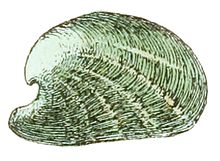Juliidae
| Juliidae Temporal range: Paleocene?/Eocene–recent |
|
|---|---|
 |
|
| A live individual of an unidentified species of Juliidae | |
 |
|
| A drawing of the shell (the exterior of the right valve) of a taxon named "Julia borbonica" | |
| Scientific classification | |
| Kingdom: | Animalia |
| Phylum: | Mollusca |
| Class: | Gastropoda |
| (unranked): |
clade Heterobranchia Informal group Opisthobranchia |
| Superfamily: | Oxynooidea |
| Family: |
Juliidae E. A. Smith, 1885 |
| Genera | |
|
See text |
|
Informal group Opisthobranchia
clade Sacoglossa
clade Oxynoacea
See text
Juliidae, common name the bivalved gastropods, is a family of minute sea snails, marine gastropod mollusks or micromollusks in the superfamily Oxynooidea, an opisthobranch group. These are sacoglossan (sap-sucking) sea snails, and many of them are green in color.
These snails are extremely unusual in that their shells consist of two separate hinged pieces or valves. The valves are joined by a ligament, and look nothing like a normal snail shell; instead the valves look almost exactly like the two hinged valves of a clam, a bivalve mollusk, a related but very different class of mollusks.
In the past the Juliidae were known only from fossil shells, and not surprisingly these fossils were interpreted as being the shells of bivalves. Julia, which is the type genus of the family, was named in 1862 by Augustus Addison Gould, who described it as a bivalve genus. Julliidae are known from the Eocene period to the Recent, but they probably first appeared during the Paleocene.
These bivalved gastropods were for a long time only known from fossils and dead material. Because of this, they had been described as being somewhat atypical bivalves. In the late 19th century they were classified among the bivalves, within the family Mytilidae, the mussels.
...
Wikipedia
